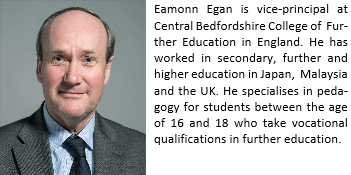Incentives to employers, colleges and their students to try and bridge the gap between the skills FE students achieve by the time they leave college and what government believes UK industry needs to succeed, will not result in a sufficient narrowing of the skills gap, writes Eamonn Egan.
Twenty seventeen saw the UK take a step in the right direction in dealing with the country’s skills shortages. It came in the shape of an amendment to the Government’s Technical and Further Education Bill.
Since September last year, schools have been required to produce a policy giving further education colleges and representatives from other competitive sources of learning and training the right to have access to Year 10 and 11 pupils, to give them information on vocational education and training and apprenticeships. Lord Baker, who tabled the amendment, commented that it would need significant support from the Government, as it would be met with great hostility in every school in the country.
You might ask: why such hostility from schools? The answer to that is at the heart of the skills dilemma.
What the Government really wants, is that FE colleges pick up the students who get the least from the school system when they are 16.
In 2015-16, across England and Wales, 62.6 per cent of students in state-funded schools achieved A*-C grades in both GCSE English and GCSE mathematics, a key success indicator for schools. The percentage of students entering further education (FE) colleges the following year with both A*-C grades in GCSE English and GCSE mathematics was 34 per cent. In other words, FE colleges pick up large numbers of students from local schools who achieved less well than their peers; the ones who stay in sixth form and take A-levels.
It is a role FE colleges play that is largely unacknowledged by government and the media. Students typically stay at college for two years, during which time it is expected that they are transformed, on mass, into the skilled workforce the country is crying out for.
What the Government says it wants from its further education sector is that it produces the skilled workforce the country needs to compete in a global marketplace. What the Government really wants, is that FE colleges pick up the students who get the least from the school system when they are 16.
The dilemma is deeply embedded in the way UK education works.
School teachers are university graduates; people who have benefitted from the school system as it is, the large majority of whom did well in their GCSEs, completed A-levels, and went on to university, before taking a Postgraduate Certificate in Education (PGCE) and entering the teaching profession as primary or secondary school teachers.
As a body of people, school teachers simply have little or no experience or knowledge of 16-18 vocational education.
When advising their Year 11 students, school teachers err on the side of the path that served them and their peers well; the academic route of A-levels and university. Add to this that schools have a captive Year 11 audience as potential A-level students for their own sixth forms, and it is easy to see why Year 11 students across the country have rarely received full and impartial information and advice about vocational education and training as a potential progression route when they finish Year 11.
Schools are aware though that some students would struggle with A-levels, and won’t do well enough in their GCSEs to get onto an A-level programme. It is these students that schools direct to their local college. The students themselves validate the system by duly making their way down to their local FE college. But then, what else are they to do?
The issue of skills gaps in the UK workforce may present itself as an economic and political problem. It is in fact a social problem. Most people in government and the media aren’t looking for the change they talk about.
Incentives to employers, colleges and their students to try and bridge the gap between the skills levels FE students achieve by the time they leave college, and what the Government believes UK industry needs to succeed, will not result in a sufficient narrowing of the skills gap UK industry is currently experiencing. Much more needs to be done in the school system, in the way vocational education and training is represented to school students before they finish Year 11.
Virtually everyone in the school system, in Government and the civil service benefitted from the school system as it is. Tampering with it would change a social system that has benefitted them and their peers all their lives. While they complain about the woes of further education and the skills gaps suffered by UK industry, the Government, the civil service and the media in fact have things the way they want them. What they say they want is for skills gaps in the UK to reduce. But what they really want is a continuation of the status quo. And so the hostility referred to by Lord Baker.
The issue of skills gaps in the UK workforce may present itself as an economic and political problem. It is in fact a social problem. Most people in government and the media aren’t looking for the change they talk about. The people doing the looking are in the FE colleges themselves, in the way they aspire for their students to achieve things during their two years at college, that they never thought themselves capable of, when they were at school.
The April 2017 amendment to the Technical and Further Education Bill is a small step, unlikely by itself to drive the kind of change the country will need if it really is to produce the skilled workforce that’s required, but nevertheless a step in the right direction.
Headline Image Credit: Maridav/Shutterstock.com 




